On the Run or Stationary Ambush
As a bowhunter, its arguable that at the moment of the release, the crux of the shot, that our digits affixed to the end of our hands are most influential to our success. The fingers play an important role, from the obvious task of hooking the string to others typically taken for granted, including pulling the zipper on your pack or opening the Snickers wrapper to expose the cold, brick-like snack.
Whatever role they may serve, our fingers and their dexterity separate us from much of the mammalian world. Taking care of our hands and fingers is a simple task when hunting most months of early fall. Yet, when the weather turns and snow falls, the extremities will be the first to lose circulatory flow. Unless you are gifted with a V-8 driven vascular system, you will be well familiar with the needling pain of frosting fingers. As someone who spends a vast amount of time dedicated to hunting between the solstices, I will attest to the value of a fool proof warming system.
Before I wade into the weeds, I will preface my comments with the notion that discussing gear is akin to discussing religion or politics at a dinner party. You are likely to get a mix of responses, all charged with emotion, not one of which is categorically incorrect. My system and approach are not without flaw, but it has kept my fingers from turning into rubber nobs. The first step I use is to establish the conditions and environment. Sitting in a tree stand, frosted to the seat in mid-December along a Kansas river bottom is going to require a much different gear set than post-holing through knee-deep snow and trailing a pack of hounds across nearly impassable terrain. My activity level and the need to readily access my bow or perform other tasks requiring dexterity will dictate my choice of glove. Let’s use some comparative scenarios for the gear analysis.
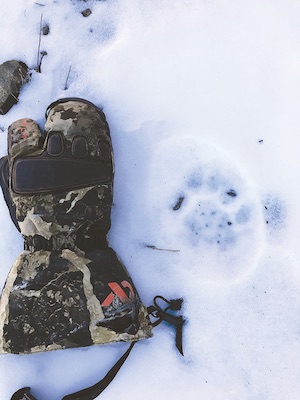
David Hoff’s outer layer glove on a cougar pursuit.
When positioned 20 feet above a frosted river bottom, chasing late season bucks finally coming out of lockdown, temperatures can hover well below freezing. Combine that with a nipping wind, minimal physical movement, and high humidity, it won’t take long to lose the dexterity of your fingers in the moment that counts. In this situation, I tend toward the use of a merino liner glove paired with a quarterback-style hand muff filled with a couple of hand warmers. With a little practice, shooting with the liner glove is possible while keeping your shot accurate. This combination allows me to keep my hands comfortable, mobile, and readily available with little movement or sound when that reclusive buck finally decides to move late in the afternoon, hours after my initial climb into the tree.
Now, let’s look at the opposite side of the spectrum when physical activity is high, the need for quiet access to the use of my fingers is irrelevant, and the environment is demanding. This could be representative of a second rut hunt in northern New Mexico, a late November elk hunt on the Mogollon Rim in Arizona or chasing a pack of hounds through the Colorado high country in the dead of winter. While a hand muff might still come into play during periods of inactivity, it’s impractical to think about walking in uneven terrain with hands stuffed at your hips. Still needing dexterity of my fingers whether for a zipper, operating electronics, or taking a shot, I employ the liner technique.Through trial and error, a few frostbit fingertips, and a lost glove or two, my outer layer of choice is an insulated three-finger glove/mitten cross. With a thumb and pointer finger available, it’s less likely to require removal for the simple operation of a zipper or grabbing a drink of water yet provides the warmth of a full-size mitten. If removal is required, each has a tether attaching the line to your wrist. I can’t count the times this has saved me walking out, one hand stuffed into a pocket while navigating with the other. Add a hand warmer into the mittens to perfect the system.
Most of your top hunting brands carry a muff, liner glove, and Martian mittens. Sitka and First Lite are both good starting points, but don’t be afraid to venture into your local mountaineering store’s bargain bin. Look for a merino or sheep’s wool liner glove and a waterproof outer shell for the mitten. Most of your top brands will sell the muff or mitten with a wind shear layer, which is handy for increasing the life of those hand warmers. Coming around full circle, I’ll leave you with the high points: Tune the system to the pursuit, practice your choice before relying on its performance, and buy a pack of hand warmers to start the season.
David Hoff
Gloves and Seasonal Challenges
Traditional bowhunting is fraught with challenges. Indeed, isn’t that why most of us do it? I have always been envious of the stickbow folks I’ve seen who can substitute their shooting glove with a pair of hardware store work gloves and get the job done. Unfortunately, this has not been my experience, which has made choosing gloves one more in the long line of struggles I experience within traditional bowhunting. For those of us in the North or Mid-West, gloves are not an optional piece of kit. They are an absolute necessity. And in my case, a necessary evil.
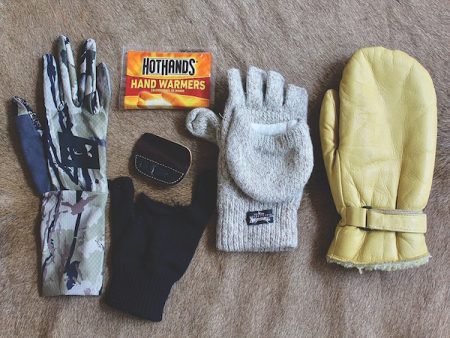
From left to right: Light merino liner gloves, modified mid-weight merino gloves, rag wool glomitts, and heavy, insulated leather mittens.
As a tab shooter, I find that the more I add between my fingers and the leather of my tab, the farther my point of impact wanders. This can also be true for super bulky materials between my anchor point and draw hand. Thick gloves can throw my lefts and rights way off. These considerations have made keeping my hands warm enough to make good on those all too rare opportunities an exercise in experimentation. One might even kindly describe some of my solutions as “banger.” Thus, for those of you who want reviews of the newest and fanciest handwear, please accept my apologies in advance.
For early season, or warm weather hunting, I see the issue of hand coverings as a question of camouflage. My go-to for most spring, August, and September hunting is either a pair of super thin merino liner gloves, or even just some mud or face paint smeared on my hands to dull their shine. The gloves I choose during these conditions are simply the thinnest available and thus don’t affect my shooting noticeably.
When hunting from a ground blind during early or mid-season, I normally use a stretchy pair of mid-weight, black merino gloves that I have modified by cutting the middle three fingers from the draw-hand. This allows me to keep my fingers directly on the tab. A little face-paint on the exposed backs of my fingers completes the black-out effect.
Fingerless, rag wool glomitts are my go-to when the lighter stuff no longer cuts it. My fingers retain direct contact with the leather, and the slightly heavier fabric between my face and draw-hand is easily accounted for if I practice with the gloves on.
When the weather turns nasty and winter once again finds its teeth, I use an eclectic mix of handwear, chemical handwarmers, and hand-warmer pockets to stay effective in the field. On my bow hand, I usually opt for a heavy, insulated, leather mitten, a thin liner glove, and a chemical hand warmer in between. However, care must be taken when wearing bulky handwear on the bow hand, as I have had the fabric or leather extend above the bow shelf and interfere with arrow flight.
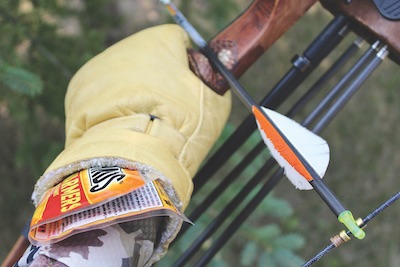
Pocket warmers can be slipped into heavy mittens to help keep your hands warm in cold weather.
When the mercury dips and frostbite is a real danger in mere minutes, the choice of gloves can literally be a hunt maker or hunt breaker. I specifically choose my outer layers with my hands in mind, opting for garments with hand warmer pockets, a kangaroo style pouch, or a hand muff. On my draw hand, I often continue to use my mid-season fingerless rag wool glomitt with a super thin liner and a chemical handwarmer taped against the back of my hand. I keep my draw hand snug and toasty in a hand warmer pocket and remove it only when I feel a shot to be imminent. Here is where gear cannot make up for experience as I must balance not getting busted moving my hand to the string against the limited time I can expose my fingers to the sometimes minus-25-degree cold. I delay removing my hand from the warmth of the pocket until the last opportunity for unnoticed movement, at which time my plan becomes to simply suffer the biting cold, until the shot opportunity either arrives or evaporates. I find the chemical hand warmer stuffed down the back of the glove aids in warming the blood flowing to my cold, burning fingers, buying me a little extra time before I am forced to return them to safe refuge.
Whether you can simply throw on a leather work glove and go hunting or, like me, you must experiment, gloves in the North and the Midwest can make or break your hunt. You can’t be effective if your hands are not comfortably warm, but you can’t hit what you are shooting at because of it. Likewise, you won’t fill your freezer if your fingers are too frozen to allow a clean release of the string.
I don’t normally consider myself in a position to provide “expert advice,” so I simply offer here what “works for me.” However, one piece of advice I do feel qualified to pass on is this: No matter what handwear you choose, practice shooting with it well in advance of your hunt.
Ben S. Kuchta
Gloves in the Early Season
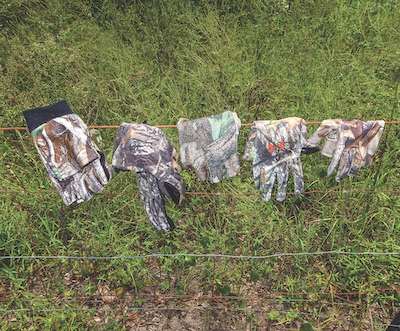
A sampling from David Tetzlaff’s glove collection that keep his hands protected from early season triple-digit hunts to late season frosty mornings.
The shot was 22 steps and the tracking job, although entirely unnecessary, was half the distance. Pleased with a careful stalk and a kneeling shot, and neglecting to consider things that bite or sting, I reached into the saw palmetto and hefted out the 70-pound heart-shot pig. A day later, however, I felt a tad punky and noticed a tiny red mark on my right hand. Something in that palmetto patch obviously took exception to the disruption caused by my hog retrieval. Looking in the rearview, even a thin pair of gloves might have prevented what may well have been a spider bite. A bit of internet investigation revealed that my assumption of just two types of widow spiders (black and the invasive brown) in Florida was incorrect. We also have the tiger widow and red widow. The latter is said to prefer the crowns of saw palmettos to build their web nests.
For years, I was a holdout in the glove department on early season hunts. As a full-time Florida resident, I have a decent year-round tan, so I’m not overly concerned about pale, untanned hands flashing in the woods. But after the incident described above, I began to rethink my position on handwear. At that point in time, my glove collection was better suited for the temperatures of late-season Florida hunts or my occasional appearances in points north. However, on a random trip to a big box outdoor store, I discovered that thin, comfortable camo gloves were available. I bought an experimental pair, found them effective, and soon purchased several more sets. They are thin enough that I still have solid contact with my tab and the grip on my recurve.
Along with the addition of gloves to my hot weather outdoor attire, I also switched to the long-sleeved shirts produced by the tech-wear companies. For too long I hunted glove-less and in short-sleeved cotton t-shirts, but no more. Mosquitoes, regardless of the temperature, are omnipresent throughout most of our seasons from the archery opener to general weapon closer. I managed with short-sleeves and no gloves mostly due in part to an insect repellent that is no longer on the market. It was virtually scent-free and very effective. Nowadays, I use a Thermacell to flag off mosquitoes and spray all my outerwear, including gloves, with Sawyer brand insect repellent. This product effectively discourages ticks, and mosquitoes to some extent as well. (Clothes, after treatment, must be allowed to thoroughly dry before wearing them.)

Bare-handed no more. These thin gloves keep David’s hands camouflaged and protected on humid Florida hunts.
I typically don’t hunt in the conditions described by David Hoff or Ben Kuchta, but as with desert or African hunts, mornings in the South can begin relatively chilly but by afternoon, the temperatures can be quite mild. With that in mind, I will pack two sets of gloves, a pair to keep me comfortable for a sit in the 30s or 40s and a thin pair for an afternoon hunt when temperatures may be in the 70s. I, too, do not care for thick gloves that prevent feeling my finger tab, so I prefer thick, but fingerless gloves on cold mornings. And I have learned the hard way to ensure, as I settle into my stand, that I save donning my gloves for the last step. Rather than leave them laying on the seat or across the rails of my climbing stand, I keep them in my pocket where they can’t be bumped and end up in the duff below.
I am certain that any glove will perform well as hand camouflage and protection against the elements or insect bites or stings. But with gloves I have also found a new sense of comfort if I’m on a difficult hands and knees tracking job. Gloves are obviously not a barrier to snakebite, for example, but they can provide basic protection from most things one’s hands might encounter in that scenario. A quality pair of leather gloves is a good choice when hand protection is a concern while on a complicated blood trail (or even performing camp chores or clearing shooting lanes for that matter). The pair I bought from Cabela’s 20 years ago are still in reasonably good shape.
David Tetzlaff


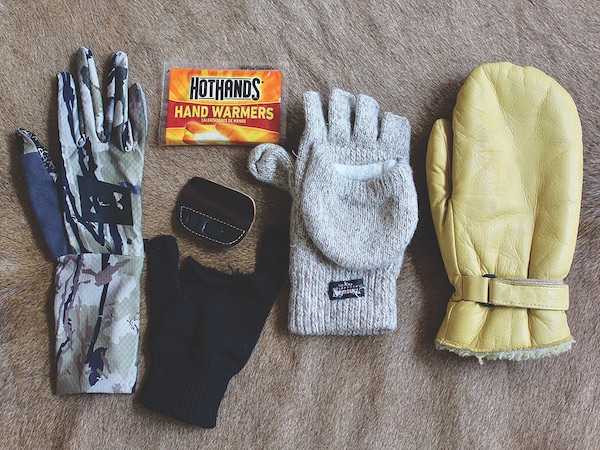


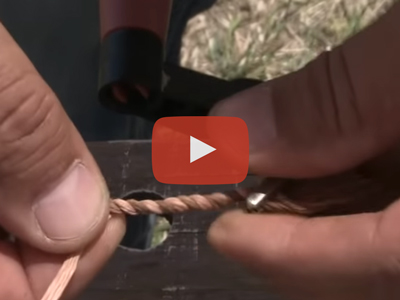
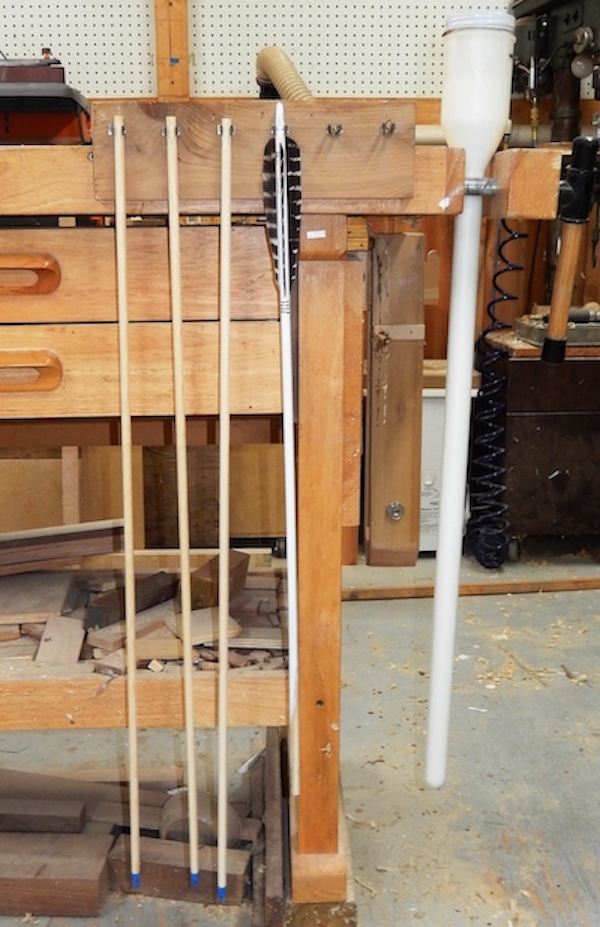
Leave A Comment